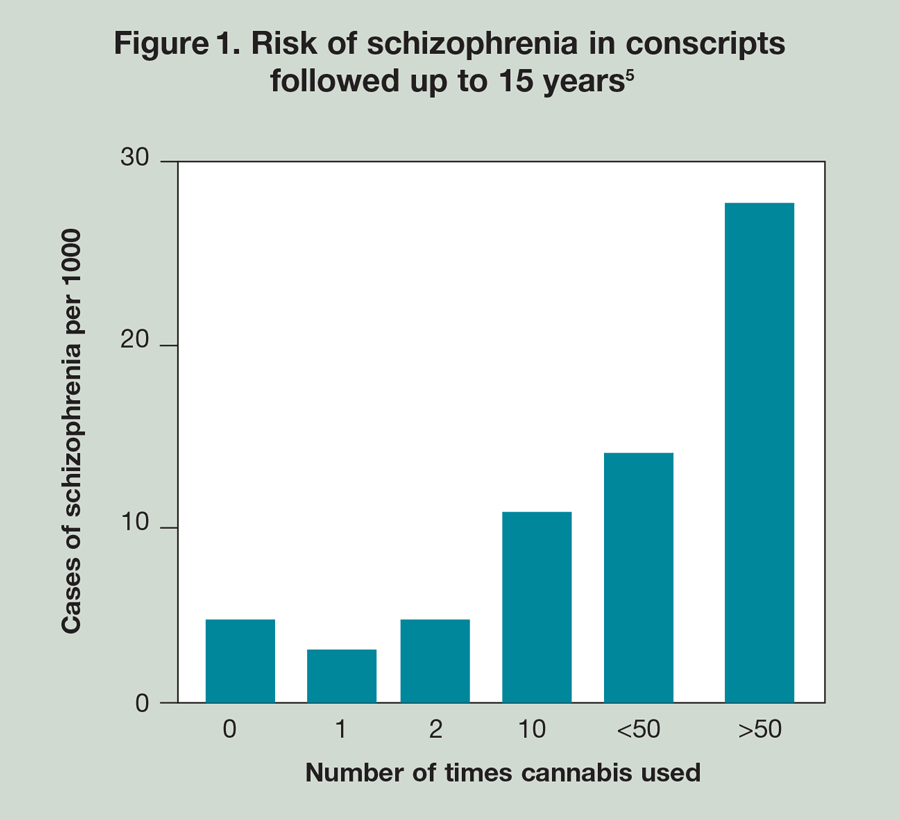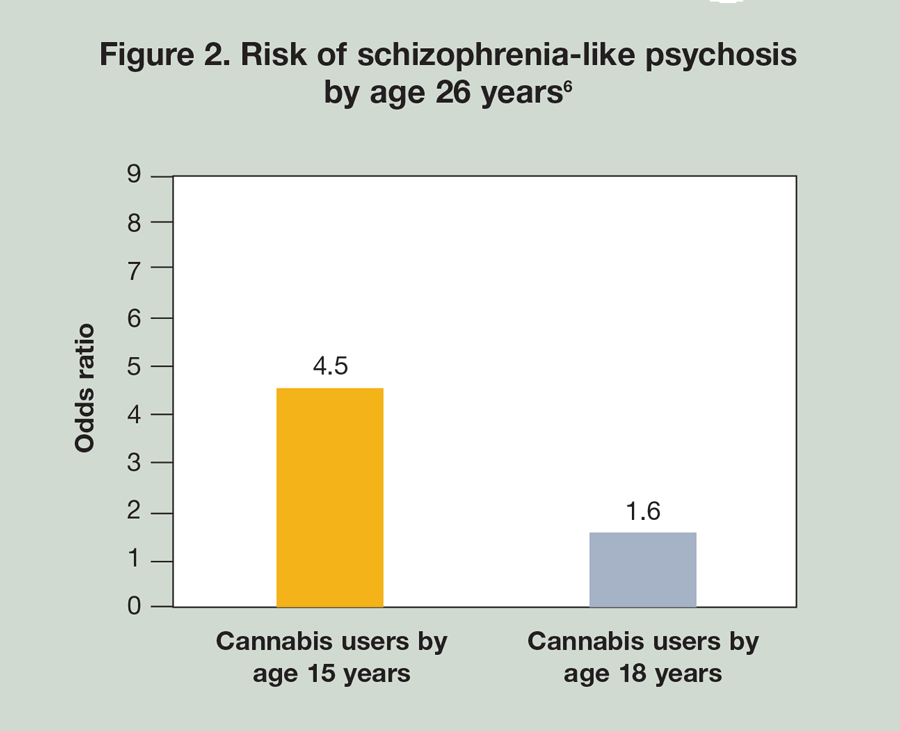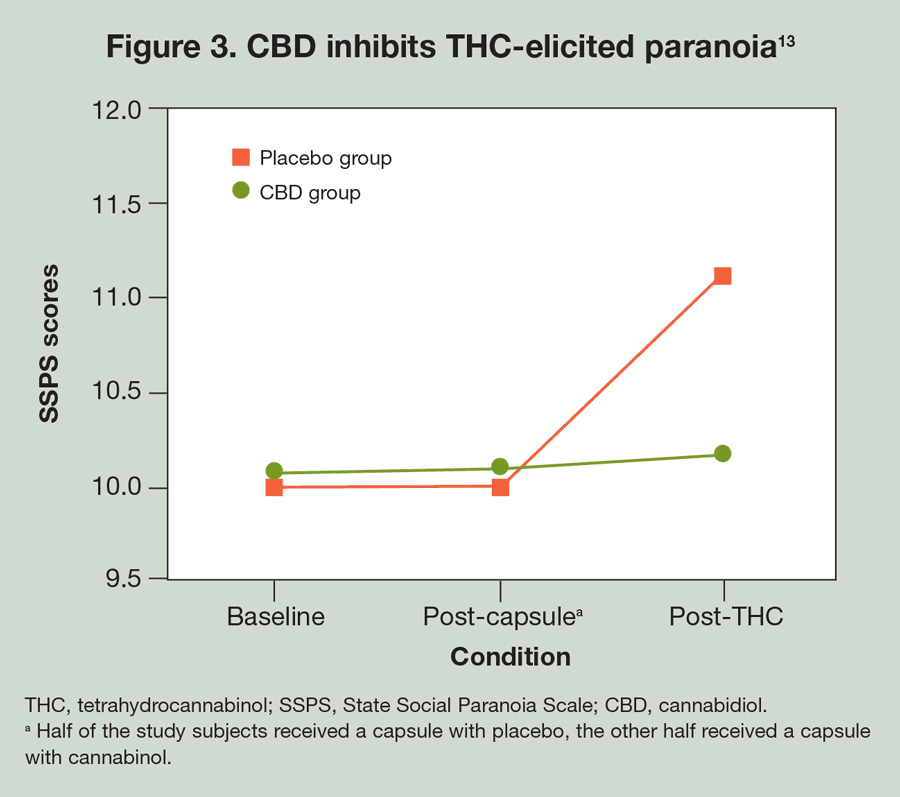Publication
Article
Psychiatric Times
Marijuana and Madness: Clinical Implications of Increased Availability and Potency
Author(s):
Current trends are toward relaxing laws on cannabis, but no one knows the likely outcome. Will legalization mean an increase in consumption? Psychiatrists will be on the front lines if and when problems arise.
Figure 1

Figure 2

Figure 3

Could It Be All the Marijuana?

Attitudes toward cannabis are changing. Uruguay has legalized its use as have 4 American states; Jamaica is in the process of following suit. In addition, 17 US states have decriminalized cannabis, while 23 others have passed medical marijuana laws.
In many ways, cannabis is similar to alcohol; most of those who use it do so moderately, enjoy it, and suffer few if any adverse effects. However, in a minority of heavy users, problems develop. Given the likelihood that cannabis will become more available, it is important to establish any harms its use may cause so clinicians can identify and treat these. The main psychological harms that have been reported are dependence, cognitive impairment, and psychosis.
Why do people enjoy smoking cannabis?
The cannabis plant produces compounds known as cannabinoids in glandular trichomes, mostly around the flowering tops of the plant. Recreational cannabis is derived from these and has been traditionally available as herb (marijuana, grass, weed) or resin (hashish, hash). The cannabis plant produces more than 70 cannabinoids, but the one responsible for the “high” that users enjoy is tetrahydrocannabinol (THC). This activates the CB1 receptor, part of the endocannabinoid system, which, in turn, affects the dopaminergic reward system that is altered by all drugs of abuse.
Psychological dependence and tolerance can occur with cannabis. It remains in the body for several weeks, so withdrawal is very gradual but anxiety, insomnia, appetite disturbance, and depression can develop. Some reports claim that in 10% of persons who use cannabis and in 25% of daily users, dependence develops.1 Cannabis dependence is an increasingly common reason why patients seek help from drug treatment clinics.
Cognitive impairment
Many studies implicate adolescent cannabis use with poor subsequent educational achievement. Silins and colleagues2 observed more than 2500 young people in Australia and New Zealand. Their findings suggest that daily cannabis use before age 17 was associated with “clear reductions” in the likelihood of completing high school and obtaining a university degree.
THC disrupts the function of the hippocampus, a structure crucial to memory, and when it is given to volunteers, transient cognitive impairment is seen. Such impairment likely is why drivers under the influence of cannabis are at double the risk for traffic accidents.2 Long-term users show more obvious deficits, but questions remain about what happens when they stop. Some studies suggest they can recover fully, while others indicate that only partial recovery is possible.3
Risk of psychosis
It has long been known that persons with schizophrenia are more likely to smoke cannabis than is the rest of the population. Until recently, the general view was that they must be smoking to self-medicate or otherwise help them to cope with their illness. If this were so, then one might expect psychotic cannabis users to have a better outcome than non-users. However, the opposite is the case; the patients who continue to use cannabis are much more likely to continue to have delusions and hallucinations.4
However, this does not prove that cannabis use causes the poor outcomes. The possible causal role of cannabis can only be answered by prospective epidemiological studies. In the first of these, 45,750 young men were asked about their drug use when they were conscripted into the Swedish army.5 Those who had used cannabis more than 50 times when conscripted, were 6 times more likely to receive a diagnosis of schizophrenia over the next 15 years(Figure 1). Since 2002, a series of prospective studies have confirmed that individuals who used cannabis at the baseline evaluation had a great-er risk of subsequently developing psychotic symptoms or full-blown schizophrenia than non-users.4-7
Some skeptics have suggested that perhaps those who are predisposed to schizophrenia are especially likely to use cannabis. However, in the Dunedin birth cohort study, the subjects were intensively studied since childhood, so those who had already appeared psychosis-prone at age 11 were excluded.6 The researchers found a link between cannabis use and later schizophrenia, even when the effects of other drugs known to increase risk of psychosis were excluded (Figure 2). Another criticism was that some individuals might have been using cannabis in an attempt to ameliorate symptoms of psychosis or its precursors. However, a second New Zealand study, this time from Christchurch, showed that once minor psychotic symptoms developed, individuals tended to smoke less.7
Anyone familiar with the effects of alcohol would immediately accept that the frequency of drinking is relevant to its adverse effects. The same is true with cannabis; long-term daily users are most at risk. Nevertheless, the majority of daily users will not become psychotic. Indeed, when a young man in whom schizophrenia has developed after years of smoking cannabis is asked whether he thinks his habit may have contributed to the disorder, he might answer, “No, my friends smoke as much as I do, and they’re fine.” It seems that some people are especially vulnerable.
Individuals with a paranoid personality are at greatest risk, along with those who have a family history of psychosis. Inheriting certain variants of genes that influence the dopamine system, which is implicated in psychosis, may also make some users especially susceptible; examples include AKT1, DRD2, and possibly COMT.8,9
Changes in potency
In 1845, French psychiatrist Jacques-Joseph Moreau used cannabis and gave it to some of his students and patients. He concluded that cannabis could precipitate “acute psychotic reactions, generally lasting but a few hours, but occasionally as long as a week.”10 Modern experimental studies confirm that intravenous administration of THC in healthy volunteers can produce acute psychotic symptoms in a dose-dependent manner.8
The proportion of THC in traditional marijuana and resin in the 1960s was approximately 1% to 3%. Potency began to rise in the 1980s, when cannabis growers such as David Watson, commonly known as “Sam the Skunkman,” fled the Reagan-inspired “War on Drugs” and brought cannabis seeds to Amsterdam, where cannabis could be sold legally in “coffee shops.” Together with Dutch enthusiasts, they bred more potent plants, setting the scene for a slow but steady increase in new varieties of marijuana, including sensimilla (often called “skunk” because of its strong smell) harvested from unpollinated female flowers. The proportion of THC in sensimilla has risen to between 16% and 20% in England and Holland, respectively, and high-potency varieties have taken over much of the traditional market9,11; the same trend, although lagging a few years behind, has occurred in the US.12
Traditional cannabis often contained not only THC but an equivalent amount of cannabidiol. This has been shown in experimental studies to ameliorate the psychotomimetic effects of THC, and possibly to have antipsychotic properties (Figure 3).13 However, plants bred to produce a high concentration of THC cannot also produce much cannabidiol, so the high THC types of cannabis contain little or no cannabidiol. Such varieties are more psychotogenic; one study showed that persons who used high-THC–low-cannabidiol cannabis on a daily basis were 5 times more likely than non-users to suffer from a psychotic disorder.14 Another study that tested hair for cannabinoids showed that users with both detectable THC and cannabidiol in their hair had fewer psychotic symptoms than those with only THC.15
The increasing availability of high-potency cannabis explains why psychiatrists are more concerned about cannabis now than they were in the 1960s and 1970s. The trend toward greater potency continues: new forms of resin oil reportedly contain up to 60% of THC.11 These very potent forms remain unusual, but synthetic cannabinoids, often termed “spice” or “K2,” are now commonly advertised and sold on Web sites that keep within the law by labeling their products as incense-or adding “not for human consumption.” While THC only partially activates the CB1 receptor, most spice/K2 molecules fully activate the receptor and, consequently, acute adverse reactions are more common. A survey of 80,000 drug users showed that those who used synthetic cannabinoids were 30 times more likely to end up in an emergency department than users of traditional cannabis.16
Cannabis and the developing brain
It seems that starting cannabis use in early adolescence increases the likelihood of problems. For example, in the Dunedin study, those starting at 18 years or later showed only a nonsignificant increase in the risk of psychosis by age 26, but among those starting at age 15 or earlier, risk was increased 4-fold (Figure 2).6
Those starting cannabis use early also appear more likely to develop cognitive impairment. Pope and colleagues17 found that long-term heavy cannabis users who began smoking before age 17 had lower verbal IQ scores than those who began smoking at age 17 or older. Meier and colleagues18 followed a birth cohort in Dunedin, New Zealand, up to age 38 years. Their findings suggest that persistent cannabis use over several decades causes a decline of up to 8 points in IQ; such dramatic findings need to be replicated before they can be accepted.
The results from animal studies also show that THC administration produces a greater effect on cognitive function in juvenile rats than in adult rats. Moreover, imaging studies in persons with long-term, very heavy cannabis use indicate detectable brain changes, especially in those who started smoking in adolescence.19 Although the studies remain contentious, a possible explanation is that beginning cannabis use at an age when the brain is still developing might permanently impair the endocannabinoid system; this may affect other neurotransmitters, such as dopamine-known to be implicated in both learning and in psychosis.
Implications
Cannabis is now generally recognized as a contributory cause of schizophrenia. Although psychosis develops in only a small minority of cannabis users, when you consider that almost 200 million people worldwide use cannabis, the number of people who suffer cannabis-induced psychosis is likely to be in the millions, and the impact on mental health services is significant. The proportion of psychosis that has been attributed to cannabis use in different countries ranges from 8% to 24%, depending, in part, on the prevalence of use and the potency of the cannabis.16
Politicians have the difficult job of balancing the enjoyment that many people get from cannabis against the harm that afflicts some people. Furthermore, cannabis can alleviate chronic pain or symptoms associated with chemotherapy. Medical marijuana may be largely a cover used by the increasingly powerful marijuana industry to introduce recreational use, but research into the numerous components of cannabis should be encouraged, since it may produce drugs with important therapeutic uses.
Current trends are toward relaxing laws on cannabis, but no one knows the likely outcome. Will legalization mean an increase in consumption? Early reports from Colorado and Washington suggest an increase. Will this have knock-on effects on use by those in their early teens who seem most susceptible to adverse effects? Will the mental health and addiction services be able to cope? How effective will educational campaigns regarding the risks of regular use of high-potency cannabis or synthetic cannabinoids be? Might a simple genetic test reveal who is most likely to suffer adverse mental effects?
Many questions remain to be answered. In the meantime, as cannabis use continues to win acceptance, psychiatrists are likely to see more of the casualties.
Disclosures:
Sir Robin Murray is Professor of Psychiatric Research at the Institute of Psychiatry, King’s College London. He has received honoraria for lectures from Janssen, Lundbeck, Otsuka, Bristol-Myers Squibb, and Roche.
References:
1. Hall W. What has research over the past two decades revealed about the adverse health effects of recreational cannabis use? Addiction. 2015;110:19-35.
2. Silins E, Horwood LJ, Patton GC, et al; Cannabis Cohorts Research Consortium. Young adult sequelae of adolescent cannabis use: an integrative analysis. Lancet Psychiatry. 2014;1:286-293.
3. Solowij N. Cannabis and Cognitive Functioning. Cambridge, UK: Cambridge University Press; 1998.
4. Casadio P, Fernandes C, Murray RM, Di Forti M. Cannabis use in young people: the risk for schizophrenia. Neurosci Biobehav Rev. 2011;35:1779-1787.
5. Andréasson S, Allebeck P, Engström A, Rydberg U. Cannabis and schizophrenia: a longitudinal study of Swedish conscripts. Lancet. 1987;2:1483-1486.
6. Arseneault L, Cannon M, Poulton R, et al. Cannabis use in adolescence and risk for adult psychosis: longitudinal prospective study. BMJ. 2002;325:1212-1213.
7. Fergusson DM, Horwood LJ, Ridder EM. Tests of causal linkages between cannabis use and psychotic symptoms. Addiction. 2005;100:354-366.
8. Morrison PD, Zois V, McKeown DA, et al. The acute effects of synthetic intravenous Delta9-tetrahydrocannabinol on psychosis, mood and cognitive functioning. Psychol Med. 2009;39:1607-1616.
9. Potter DJ, Clark P, Brown MB. Potency of delta 9-THC and other cannabinoids in cannabis in England in 2005: implications for psychoactivity and pharmacology. J Forensic Sci. 2008;53:90-94.
10. Murray RM, Morrison PD, Henquet C, Di Forti M. Cannabis, the mind and society: the hash realities. Nat Rev Neurosci. 2007;8:885-895.
11. van Laar M, Cruts G, van Ooyen-Houben M, et al. Trimbos Institute. Report to the EMCDDA by the Reitox National Focal Point: the Netherlands Drug Situation 2014. http://www.trimbos.nl/~/media/files/gratis%20downloads/af1367%20the%20netherlands%20drug%20situation%202014%20a4-web.ashx. Accessed March 17, 2015.
12. Mehmedic Z, Chandra S, Slade D, et al. Potency trends of Î9-THC and other cannabinoids in confiscated cannabis preparations from 1993 to 2008. J Forensic Sci. 2010;55:1209-1217.
13. Englund A, Morrison PD, Nottage J, et al. Cannabidiol inhibits THC-elicited paranoid symptoms and hippocampal-dependent memory impairment. J Psychopharmacol. 2013;27:19-27.
14. Di Forti M, Marconi A, Carra E, et al. Proportion of patients in south London with first-episode psychosis attributable to use of high potency cannabis: a case-control study. Lancet Psychiatry. February 18, 2015. http://www.thelancet.com/pb/assets/raw/Lancet/pdfs/14TLP0454_Di%20Forti.pdf. Accessed March 17, 2015.
15. Morgan CJ, Curran HV. Effects of cannabidiol on schizophrenia-like symptoms in people who use cannabis. Br J Psychiatry. 2008;192:306-307.
16. Winstock AR, Barratt MJ. Synthetic cannabis: a comparison of patterns of use and effect profile with natural cannabis in a large global sample. Drug Alcohol Depend. 2013;131:106-111.
17. Pope HG Jr, Gruber AJ, Hudson JI, et al. Early-onset cannabis use and cognitive deficits: what is the nature of the association? Drug Alcohol Depend. 2003;69:303-310.
18. Meier MH, Caspi A, Ambler A, et al. Persistent cannabis users show neuropsychological decline from childhood to midlife. Proc Natl Acad Sci U S A. 2012;109:E2657-E2664.
19. Battistella G, Fornari E, Annoni JM, et al. Long-term effects of cannabis on brain structure. Neuropsychopharmacology. 2014;39:2041-2048.






